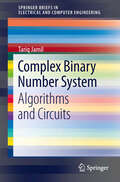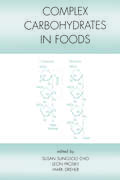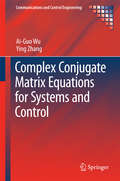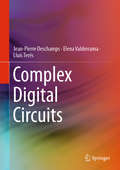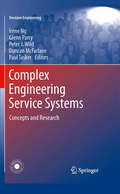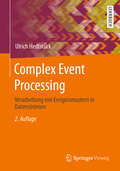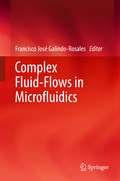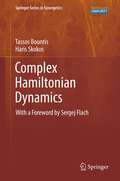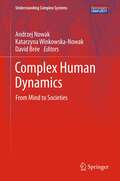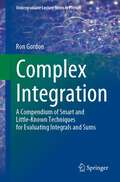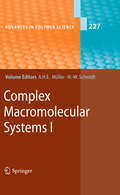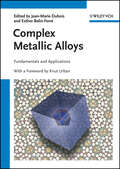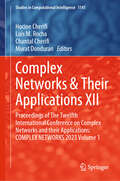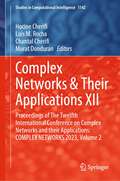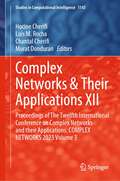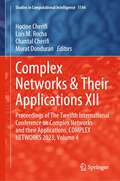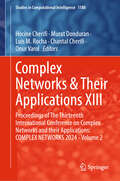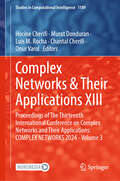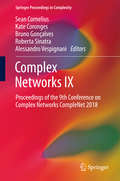- Table View
- List View
Complex Binary Number System: Algorithms and Circuits (SpringerBriefs in Electrical and Computer Engineering)
by Tariq JamilThis book is a compilation of the entire research work on the topic of Complex Binary Number System (CBNS) carried out by the author as the principal investigator and members of his research groups at various universities during the years 2000-2012. Pursuant to these efforts spanning several years, the realization of CBNS as a viable alternative to represent complex numbers in an "all-in-one" binary number format has become possible and efforts are underway to build computer hardware based on this unique number system. It is hoped that this work will be of interest to anyone involved in computer arithmetic and digital logic design and kindle renewed enthusiasm among the engineers working in the areas of digital signal and image processing for developing newer and efficient algorithms and techniques incorporating CBNS.
Complex Carbohydrates in Foods (Food Science and Technology)
by Leon Prosky Susan Sungsoo Cho Mark Dreher"Explores the effects of complex carbohydrates (starch, gums, and dietary fibers) on human physiological function and establishes an appropriate dietary intake level for inclusion on nutritional labels. Addresses current research, applications, and implementation issues."
Complex Conjugate Matrix Equations for Systems and Control (Communications and Control Engineering)
by Ying Zhang Ai-Guo WuThe book is the first book on complex matrix equations including the conjugate of unknown matrices. The study of these conjugate matrix equations is motivated by the investigations on stabilization and model reference tracking control for discrete-time antilinear systems, which are a particular kind of complex system with structure constraints. It proposes useful approaches to obtain iterative solutions or explicit solutions for several types of complex conjugate matrix equation. It observes that there are some significant differences between the real/complex matrix equations and the complex conjugate matrix equations. For example, the solvability of a real Sylvester matrix equation can be characterized by matrix similarity; however, the solvability of the con-Sylvester matrix equation in complex conjugate form is related to the concept of con-similarity. In addition, the new concept of conjugate product for complex polynomial matrices is also proposed in order to establish a unified approach for solving a type of complex matrix equation.
Complex Contracting
by Matthew Potoski Trevor L. Brown Matthew Potoski David M. Van Slyke Trevor L. BrownComplex Contracting draws on core social science concepts to provide wide-ranging practical advice on how best to manage complex acquisitions. Using a strong analytical framework, the authors assess contract management practices, suggesting strategies for improvement and ways to avoid the pitfalls of managing contracts for large and sophisticated projects. An in-depth analysis of the US Coast Guard's Deepwater program is included to illustrate ways to respond to real-world contracting challenges. This high-profile and controversial case consisted of a projected 25-year, $24 billion contract through which the US Coast Guard would buy a system of new boats, aircraft, communications, and control architecture to replace its aging fleet. The authors explore the reasons why this program, launched with such promise, turned out so poorly, and apply the lessons learned to similarly complex contracting scenarios. This engaging and accessible book has broad applicability and will appeal to policymakers, practitioners, scholars and students.
Complex Digital Circuits
by Jean-Pierre Deschamps Elena Valderrama Lluís TerésThis textbook is designed for a second course on digital systems, focused on the design of digital circuits. It was originally designed to accompany a MOOC (Massive Open Online Course) created at the Autonomous University of Barcelona (UAB), currently available on the Coursera platform. Readers will learn to develop complex digital circuits, starting from a functional specification, will know the design alternatives that a development engineer can choose to reach the specified circuit performance, and will understand which design tools are available to develop a new circuit.
Complex Dynamical Systems in Education: Concepts, Methods and Applications
by Matthijs Koopmans Dimitrios StamovlasisThis book capitalizes on the developments in dynamical systems and education by presenting some of the most recent advances in this area in seventeen non-overlapping chapters. The first half of the book discusses the conceptual framework of complex dynamical systems and its applicability to educational processes. The second half presents a set of empirical studies that that illustrate the use of various research methodologies to investigate complex dynamical processes in education, and help the reader appreciate what we learn about dynamical processes in education from using these approaches.
Complex Engineering Service Systems: Concepts and Research (Decision Engineering)
by Peter Wild Irene Ng Glenn Parry Paul Tasker Duncan McfarlaneFor manufacturers of complex engineering equipment, the focus on service and achieving outcomes for customers is the key to growth. Yet, the capability to provide service for complex engineered products is less understood. Taking a trans-disciplinary approach, Complex Engineering Service Systems covers various aspects of service in complex engineering systems, with perspectives from engineering, management, design, operations research, strategy, marketing and operations management that are relevant to different disciplines, organisation functions, and geographic locations. The focus is on the many facets of complex engineering service systems around a core integrative framework of three value transformations - that of material/equipment, information and people. Complex Engineering Service Systems is the outcome of the EPSRC/BAE Systems S4T (Service Support Solutions: Strategy and Transition) research programme of 10 universities and 27 researchers, which examined how high-value manufacturers of complex engineering products adapt to a multi-partnered environment to design and deliver value in a service system. Complex Engineering Service Systems aims to be the main source of knowledge for academics and professionals in the research and practice of contracting, managing, designing, leading, and delivering complex engineering service systems. The book takes a value-based approach to integrating equipment and human factors into a total service provision. In doing so, it aims to advance the field of service systems and engineering.
Complex Event Processing: Verarbeitung von Ereignismustern in Datenströmen
by Ulrich HedtstückEine wichtige Aufgabe für die IT der vernetzten Welt ist die maschinelle Auswertung und Verarbeitung von Informationen, die für eine Anwendung relevant sind und übers Netz verschickt werden. Mit Complex Event Processing (CEP) können große Mengen von zeitbehafteten Daten unterschiedlichster Art in nahezu Echtzeit analysiert und weiterverarbeitet werden. Die grundlegende Vorgehensweise beim CEP entspricht der menschlichen Entscheidungsfindung in Prozessabläufen des täglichen Lebens und stellt eine Erweiterung bekannter Methoden des Data Analytics wie Data Mining, statistische Analyse oder regelbasierte Wissensverarbeitung dar. Typische Anwendungsgebiete sind Big-Data-Systeme, Internet of Things, Industrie 4.0.
Complex Fluid-Flows in Microfluidics
by Francisco José Galindo-RosalesThis monograph contains expert knowledge on complex fluid-flows in microfluidic devices. The topical spectrum includes, but is not limited to, aspects such as the analysis, experimental characterization, numerical simulations and numerical optimization. The target audience primarily comprises researchers who intend to embark on activities in microfluidics. The book can also be beneficial as supplementary reading in graduate courses.
Complex Hamiltonian Dynamics (Springer Series in Synergetics #10)
by Haris Skokos Tassos BountisThis book introduces and explores modern developments in the well established field of Hamiltonian dynamical systems. It focuses on high degree-of-freedom systems and the transitional regimes between regular and chaotic motion. The role of nonlinear normal modes is highlighted and the importance of low-dimensional tori in the resolution of the famous FPU paradox is emphasized. Novel powerful numerical methods are used to study localization phenomena and distinguish order from strongly and weakly chaotic regimes. The emerging hierarchy of complex structures in such regimes gives rise to particularly long-lived patterns and phenomena called quasi-stationary states, which are explored in particular in the concrete setting of one-dimensional Hamiltonian lattices and physical applications in condensed matter systems. The self-contained and pedagogical approach is blended with a unique balance between mathematical rigor, physics insights and concrete applications. End of chapter exercises and (more demanding) research oriented problems provide many opportunities to deepen the reader's insights into specific aspects of the subject matter. Addressing a broad audience of graduate students, theoretical physicists and applied mathematicians, this text combines the benefits of a reference work with those of a self-study guide for newcomers to the field.
Complex Human Dynamics: From Mind to Societies (Understanding Complex Systems)
by Andrzej Nowak Katarzyna Winkowska-Nowak David BréeThis book, edited and authored by a closely collaborating network of social scientists and psychologists, recasts typical research topics in these fields into the language of nonlinear, dynamic and complex systems. The aim is to provide scientists with different backgrounds - physics, applied mathematics and computer sciences - with the opportunity to apply the tools of their trade to an altogether new range of possible applications. At the same time, this book will serve as a first reference for a new generation of social scientists and psychologists wishing to familiarize themselves with the new methodology and the "thinking in complexity".
Complex Integration: A Compendium of Smart and Little-Known Techniques for Evaluating Integrals and Sums (Undergraduate Lecture Notes in Physics)
by Ron GordonIntegrals and sums are not generally considered for evaluation using complex integration. This book proposes techniques that mainly use complex integration and are quite different from those in the existing texts. Such techniques, ostensibly taught in Complex Analysis courses to undergraduate students who have had two semesters of calculus, are usually limited to a very small set of problems. Few practitioners consider complex integration as a tool for computing difficult integrals. While there are a number of books on the market that provide tutorials on this subject, the existing texts in this field focus on real methods. Accordingly, this book offers an eye-opening experience for computation enthusiasts used to relying on clever substitutions and transformations to evaluate integrals and sums. The book is the result of nine years of providing solutions to difficult calculus problems on forums such as Math Stack Exchange or the author's website, residuetheorem.com. It serves to detail to the enthusiastic mathematics undergraduate, or the physics or engineering graduate student, the art and science of evaluating difficult integrals, sums, and products.
Complex Macromolecular Systems II (Advances in Polymer Science #227)
by Axel H. Müller Hans-Werner Schmidt-Polyelectrolyte Stars and Cylindrical Brushes By Y. Xu, F. Plamper, M. Ballauff, and A. H. E. Müller -Various Aspects of the Interfacial Self-Assembly of Nanoparticles By N. Popp, S. Kutuzov, A. Böker -Holographic Gratings and Data Storage in Azobenzene-Containing Block Copolymers and Molecular Glasses By H. Audorff, K. Kreger, R. Walker, D. Haarer, L. Kador, and H.-W. Schmidt -Donor-Acceptor Block Copolymers with Nanoscale Morphology for Photovoltaic Applications By M. Sommer, S. Huettner, and M. Thelakkat -Recent Advances in the Improvement of Polymer Electret Films By D. P. Erhard, D. Lovera, C. von Salis-Soglio, R. Giesa, V. Altstädt, and H.-W. Schmidt
Complex Metallic Alloys: Fundamentals and Applications
by Esther Belin-Ferré Jean-Marie DuboisCovering fundamental research as well as real-world applications, this first book on CMAs at an introductory level treats everything from atomistic details to surface processing. Comprehensive, self-contained chapters provide readers with the latest knowledge on the most salient features of the topic, selected in terms of their relevance to potential technological applications. Edited by one of the most distinguished authorities on quasicrystals and this most important of their subclasses, the contributions elucidate aspects of CMAs from a particular viewpoint: physical and chemical characteristics in the sub-nanometer regime, mesoscale phenomena, preparation and processing of thin films, and large-scale engineering properties. The whole is rounded off by a look at the commercial potential of CMA-based applications. For PhD students and lecturers alike.
Complex Networks & Their Applications IX: Volume 1, Proceedings of the Ninth International Conference on Complex Networks and Their Applications COMPLEX NETWORKS 2020 (Studies in Computational Intelligence #943)
by Hocine Cherifi Chantal Cherifi Esteban Moro Luis Mateus Rocha Rosa M. Benito Marta Sales-PardoThis book highlights cutting-edge research in the field of network science, offering scientists, researchers, students and practitioners a unique update on the latest advances in theory and a multitude of applications. It presents the peer-reviewed proceedings of the IX International Conference on Complex Networks and their Applications (COMPLEX NETWORKS 2020). The carefully selected papers cover a wide range of theoretical topics such as network models and measures; community structure, network dynamics; diffusion, epidemics and spreading processes; resilience and control as well as all the main network applications, including social and political networks; networks in finance and economics; biological and neuroscience networks and technological networks.
Complex Networks & Their Applications IX: Volume 2, Proceedings of the Ninth International Conference on Complex Networks and Their Applications COMPLEX NETWORKS 2020 (Studies in Computational Intelligence #944)
by Hocine Cherifi Chantal Cherifi Esteban Moro Luis Mateus Rocha Rosa M. Benito Marta Sales-PardoThis book highlights cutting-edge research in the field of network science, offering scientists, researchers, students and practitioners a unique update on the latest advances in theory and a multitude of applications. It presents the peer-reviewed proceedings of the IX International Conference on Complex Networks and their Applications (COMPLEX NETWORKS 2020). The carefully selected papers cover a wide range of theoretical topics such as network models and measures; community structure, network dynamics; diffusion, epidemics and spreading processes; resilience and control as well as all the main network applications, including social and political networks; networks in finance and economics; biological and neuroscience networks and technological networks.
Complex Networks & Their Applications XII: Proceedings of The Twelfth International Conference on Complex Networks and their Applications: COMPLEX NETWORKS 2023 Volume 1 (Studies in Computational Intelligence #1141)
by Hocine Cherifi Chantal Cherifi Luis M. Rocha Murat DonduranThis book highlights cutting-edge research in the field of network science, offering scientists, researchers, students and practitioners a unique update on the latest advances in theory and a multitude of applications. It presents the peer-reviewed proceedings of the XII International Conference on Complex Networks and their Applications (COMPLEX NETWORKS 2023). The carefully selected papers cover a wide range of theoretical topics such as network embedding and network geometry; community structure, network dynamics; diffusion, epidemics and spreading processes; machine learning and graph neural networks as well as all the main network applications, including social and political networks; networks in finance and economics; biological networks and technological networks.
Complex Networks & Their Applications XII: Proceedings of The Twelfth International Conference on Complex Networks and their Applications: COMPLEX NETWORKS 2023, Volume 2 (Studies in Computational Intelligence #1142)
by Hocine Cherifi Chantal Cherifi Luis M. Rocha Murat DonduranThis book highlights cutting-edge research in the field of network science, offering scientists, researchers, students and practitioners a unique update on the latest advances in theory and a multitude of applications. It presents the peer-reviewed proceedings of the XII International Conference on Complex Networks and their Applications (COMPLEX NETWORKS 2023). The carefully selected papers cover a wide range of theoretical topics such as network embedding and network geometry; community structure, network dynamics; diffusion, epidemics and spreading processes; machine learning and graph neural networks as well as all the main network applications, including social and political networks; networks in finance and economics; biological networks and technological networks.
Complex Networks & Their Applications XII: Proceedings of The Twelfth International Conference on Complex Networks and their Applications: COMPLEX NETWORKS 2023, Volume 3 (Studies in Computational Intelligence #1143)
by Hocine Cherifi Chantal Cherifi Luis M. Rocha Murat DonduranThis book highlights cutting-edge research in the field of network science, offering scientists, researchers, students and practitioners a unique update on the latest advances in theory and a multitude of applications. It presents the peer-reviewed proceedings of the XII International Conference on Complex Networks and their Applications (COMPLEX NETWORKS 2023). The carefully selected papers cover a wide range of theoretical topics such as network embedding and network geometry; community structure, network dynamics; diffusion, epidemics and spreading processes; machine learning and graph neural networks as well as all the main network applications, including social and political networks; networks in finance and economics; biological networks and technological networks.
Complex Networks & Their Applications XII: Proceedings of The Twelfth International Conference on Complex Networks and their Applications: COMPLEX NETWORKS 2023, Volume 4 (Studies in Computational Intelligence #1144)
by Hocine Cherifi Chantal Cherifi Luis M. Rocha Murat DonduranThis book highlights cutting-edge research in the field of network science, offering scientists, researchers, students and practitioners a unique update on the latest advances in theory and a multitude of applications. It presents the peer-reviewed proceedings of the XII International Conference on Complex Networks and their Applications (COMPLEX NETWORKS 2023). The carefully selected papers cover a wide range of theoretical topics such as network embedding and network geometry; community structure, network dynamics; diffusion, epidemics and spreading processes; machine learning and graph neural networks as well as all the main network applications, including social and political networks; networks in finance and economics; biological networks and technological networks.
Complex Networks & Their Applications XIII: Proceedings of The Thirteenth International Conference on Complex Networks and Their Applications: COMPLEX NETWORKS 2024 - Volume 1 (Studies in Computational Intelligence #1187)
by Hocine Cherifi Chantal Cherifi Luis M. Rocha Murat Donduran Onur VarolThis book highlights cutting-edge research in network science, offering scientists, researchers, students, and practitioners a unique update on the latest advances in theory and a multitude of applications. It presents the peer-reviewed proceedings of the XIII International Conference on Complex Networks and their Applications (COMPLEX NETWORKS 2024). The carefully selected papers cover a wide range of theoretical topics such as network embedding and network geometry; community structure, network dynamics; diffusion, epidemics, and spreading processes; machine learning and graph neural networks, as well as all the main network applications, including social and political networks; networks in finance and economics; biological networks and technological networks.
Complex Networks & Their Applications XIII: Proceedings of The Thirteenth International Conference on Complex Networks and Their Applications: COMPLEX NETWORKS 2024 - Volume 2 (Studies in Computational Intelligence #1188)
by Hocine Cherifi Chantal Cherifi Luis M. Rocha Murat Donduran Onur VarolThis book highlights cutting-edge research in network science, offering scientists, researchers, students, and practitioners a unique update on the latest advances in theory and a multitude of applications. It presents the peer-reviewed proceedings of the XIII International Conference on Complex Networks and their Applications (COMPLEX NETWORKS 2024). The carefully selected papers cover a wide range of theoretical topics such as network embedding and network geometry; community structure, network dynamics; diffusion, epidemics, and spreading processes; machine learning and graph neural networks, as well as all the main network applications, including social and political networks; networks in finance and economics; biological networks and technological networks.
Complex Networks & Their Applications XIII: Proceedings of The Thirteenth International Conference on Complex Networks and Their Applications: COMPLEX NETWORKS 2024 - Volume 3 (Studies in Computational Intelligence #1189)
by Hocine Cherifi Chantal Cherifi Luis M. Rocha Murat Donduran Onur VarolThis book highlights cutting-edge research in network science, offering scientists, researchers, students, and practitioners a unique update on the latest advances in theory and a multitude of applications. It presents the peer-reviewed proceedings of the XIII International Conference on Complex Networks and their Applications (COMPLEX NETWORKS 2024). The carefully selected papers cover a wide range of theoretical topics such as network embedding and network geometry; community structure, network dynamics; diffusion, epidemics, and spreading processes; machine learning and graph neural networks, as well as all the main network applications, including social and political networks; networks in finance and economics; biological networks and technological networks.
Complex Networks & Their Applications XIII: Proceedings of The Thirteenth International Conference on Complex Networks and their Applications: COMPLEX NETWORKS 2024 - Volume 4 (Studies in Computational Intelligence #1190)
by Hocine Cherifi Chantal Cherifi Luis M. Rocha Murat Donduran Onur VarolThis book highlights cutting-edge research in network science, offering scientists, researchers, students, and practitioners a unique update on the latest advances in theory and a multitude of applications. It presents the peer-reviewed proceedings of the XIII International Conference on Complex Networks and their Applications (COMPLEX NETWORKS 2024). The carefully selected papers cover a wide range of theoretical topics such as network embedding and network geometry; community structure, network dynamics; diffusion, epidemics, and spreading processes; machine learning and graph neural networks, as well as all the main network applications, including social and political networks; networks in finance and economics; biological networks and technological networks.
Complex Networks IX
by Alessandro Vespignani Bruno Gonçalves Roberta Sinatra Sean Cornelius Kate CorongesThis book aims to bring together researchers and practitioners working across domains and research disciplines to measure, model, and visualize complex networks. It collects the works presented at the 9th International Conference on Complex Networks (CompleNet) in Boston, MA, March, 2018. With roots in physical, information and social science, the study of complex networks provides a formal set of mathematical methods, computational tools and theories to describe, prescribe and predict dynamics and behaviors of complex systems. Despite their diversity, whether the systems are made up of physical, technological, informational, or social networks, they share many common organizing principles and thus can be studied with similar approaches. This book provides a view of the state-of-the-art in this dynamic field and covers topics such as group decision-making, brain and cellular connectivity, network controllability and resiliency, online activism, recommendation systems, and cyber security.
